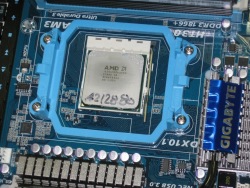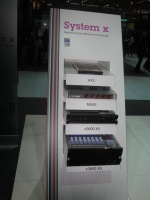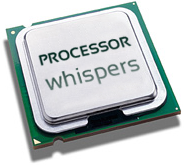Processor Whispers: About Recovering and Upgrading
by Andreas Stiller
While RISC-, Itanium- and Unix-server sales continue to drop, the x86-server market, which IBM and others are intent on reanimating, is recovering. Meanwhile, Intel has other worries.
We take this opportunity to wish Intel’s crown prince, the 53-year-old British Sean M. Maloney, a speedy recovery after suffering a stroke at home. But even if he is able, as is hoped for, to fully recover within a few months it’s likely that this shot across the bows will give the hard-working manager pause; Will he still strive for the stressful CEO position in the future? For now, his duties have been taken over by his colleague David (Dadi) Perlmutter, co-general manager of Intel’s Architecture Group, who seized the opportunity to say some strong words at an investors’ conference; amongst other things, he commented on the graphics market, saying that “relatively few” people need high performance graphics. That, of course, is easy to say after burying one’s own high performance graphics product, the Larrabee. Intel will now focus on less powerful, but also cheaper integrated graphics, a market, in which – according to Perlmutter – Intel can now offer the best solution with its graphics chips that are integrated into the processor housing. However, he also acknowledged that AMD/ATI had offered better integrated solutions up to then. Competitor AMD/ATI is also throwing more and more DirectX 11 products on the market while Intel – still unable to offer any DirectX 11 products – can only stand and watch.
Apple, according to reports from CeBIT, also plans to get its iMacs on the DirectX 11 train, or rather, on the ATI Radeon 5750 train – the Windows DirectX 11 features don’t much matter with a Mac OS X. Anyway, there is OpenCL, in the development of which Apple played a significant part. Unlike last year, Apple kept a low key during the run-up to CeBIT and didn’t surprise with news from far-away California about new Mac Pro workstations equipped with unreleased Intel Xeon processors. Like Dell, HP and others, Apple is going to behave well and present the upgrade to the 6-core Westmere-EP in due time this year. This upgrade will be rather easy as no new systems are required: the new Westmere-EP processor is socket compatible to its predecessor, the 4-core Nehalem-EP. The special feature of its integrated memory (NUMA) will most likely continue to be ignored by Apple’s operating system Snow Leopard, which means that about 20 percent or more of the memory performance is wasted. SPEC CPU2006 benchmark results are accordingly poor until now.

![]() AMD’s 6-core processor Phenom II X6 (in the Leo platform), codenamed Thuban, is slated for the second quarter.
Also desktop brother Gulftown (Core i7-980X) is experiencing memory bottleneck problems, in spite of having three memory channels. Some of the CPU 2006 suite benchmarks actually run slower with six cores than they do with four which happens when the 12 threads accidentally get in each other’s way when trying to access the memory. This should happen even more often with AMD’s new 6-core processor for desktops (codename Thuban), which AMD presented a prototype of at CeBIT – the Thuban only has two memory channels.
AMD’s 6-core processor Phenom II X6 (in the Leo platform), codenamed Thuban, is slated for the second quarter.
Also desktop brother Gulftown (Core i7-980X) is experiencing memory bottleneck problems, in spite of having three memory channels. Some of the CPU 2006 suite benchmarks actually run slower with six cores than they do with four which happens when the 12 threads accidentally get in each other’s way when trying to access the memory. This should happen even more often with AMD’s new 6-core processor for desktops (codename Thuban), which AMD presented a prototype of at CeBIT – the Thuban only has two memory channels.
Surging Ahead
Instead of Apple, this time it was IBM who could shine early with new Intel processors. However, for the press conference Big Blue shifted back a few gears compared to the preliminary briefing to be on the safe side concerning Intel’s “Non Disclosure”, so neither the processor (Xeon 65/75xx; codename Nehalem-EX) nor the interconnect (QPI) of IBM’s new eX5 series were disclosed. This was in spite of IBM having come up with something really special for this series: the eX5 rack and blade systems feature external QuickPath links that allow the connection of a memory unit (MAX5) or a second eX5 system.

![]() IBM hopes to reshape the x86-server landscape with its new eX5 family, presented at CeBIT.
The MAX5 unit contains the proprietary eX5 chipset, which runs the additional memory and has its own external links for further connections. According to IBM, the main problem for most clients is not so much a lack of computing power as a lack of more memory capacity. One does have to take into account that some software houses charge the sometimes expensive license costs per core or socket. So, a two-socket system with a large memory capacity might often be the far better choice, says IBM. With MAX5 the memory capacity of the x3850-X5-rack (256GB, 32 DIMMs with 8GB each) can be doubled to 512GB. If required, another combination of MAX5/x3690-X5 can be connected, resulting in a 4-way-SMP system with up to 1TB. This system can then be physically partitioned into two 2-way systems (FlexNode technology) in order to, for instance, run one configuration at day and another one at night. Also, there would be a fallback should one half of the 4-way system give out.
IBM hopes to reshape the x86-server landscape with its new eX5 family, presented at CeBIT.
The MAX5 unit contains the proprietary eX5 chipset, which runs the additional memory and has its own external links for further connections. According to IBM, the main problem for most clients is not so much a lack of computing power as a lack of more memory capacity. One does have to take into account that some software houses charge the sometimes expensive license costs per core or socket. So, a two-socket system with a large memory capacity might often be the far better choice, says IBM. With MAX5 the memory capacity of the x3850-X5-rack (256GB, 32 DIMMs with 8GB each) can be doubled to 512GB. If required, another combination of MAX5/x3690-X5 can be connected, resulting in a 4-way-SMP system with up to 1TB. This system can then be physically partitioned into two 2-way systems (FlexNode technology) in order to, for instance, run one configuration at day and another one at night. Also, there would be a fallback should one half of the 4-way system give out.
The twice as large x3950-X5 rack offers the same connectability and has four sockets and 64 DIMMs by default. Completely upgraded it features 8 sockets, 128 logical cores, 192 DIMMs (for 1.5TB). The new HX5 blades offer a similar amount of flexibility. Another new component that is supposed to enhance performance as well as save energy and money is ExFlash: a package consisting of eight 1.8" SSDs with 200GB each and with two RAID5 controllers.
SoftRAM reloaded
Something the eX5 chipset of the MAX5 unit does not offer is memory compression; this feature remains an exclusive characteristic of the Power systems. With the new Power7 servers it’s possible to set up a SoftRAM mode, which – in contrast to former fake products for Windows – really works. It’s necessary to assign a few cores to the compression though – but usually there are cores aplenty. Unfortunately, the cores busy with the memory compression run under the same logical partition and accordingly count as computing cores as far as licenses are concerned. So, it seems a bit of renegotiating with the software developers will still be necessary.
(djwm)

![Kernel Log: Coming in 3.10 (Part 3) [--] Infrastructure](/imgs/43/1/0/4/2/6/7/2/comingin310_4_kicker-4977194bfb0de0d7.png)

![Kernel Log: Coming in 3.10 (Part 3) [--] Infrastructure](/imgs/43/1/0/4/2/3/2/3/comingin310_3_kicker-151cd7b9e9660f05.png)
















